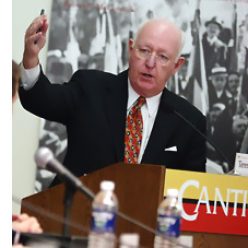MONDAY MORNING MEDIA X
Three years ago today, on June 28, 2018, a deranged gunman murdered five staffers at the office of The Annapolis Capital Gazette, the beleaguered Maryland daily that serves this state capital on the shores of the Chesapeake Bay. The attack was then and remains today the costliest assault on the press in the history of the country.
Today, several hundred people are commemorating the deaths of news editor and columnist Rob Hiaasen, 59; editorial editor Gerald Fischman, 61; community news reporter Wendi Winters, 65; sportswriter and editor Bob McNamara, 56; and sales associate Rebecca Smith, 34; by dedicating a striking new memorial to the First Amendment on the waterfront. In an ironic twist, a trial to determine whether their confessed and defiant killer was mentally stable at the time of the shooting opens tomorrow in a local courtroom. The defendant pled guilty to all five murders in an earlier trial. His only explanation was that he was settling an old score with a pair of editors who no longer worked at the paper. His lawyers assert that he was crazy.
There will be recollections of the deceased at the dedication, speeches about the importance of the first amendment, declarations by local politicians and others of the importance of local newspapers and praise for the Annapolis Capital, which was honored by the Pulitzer Prize committee for soldiering on three years ago in the wake of the shooting.
Meanwhile, another murder is taking place at the Annapolis Capital. The vulture capital firm Alden Capital, which has bought and systematically fleeced and destroyed scores of newspapers across the country in the name of short-term profit, is killing the Capital. Not with a gun, of course, but with budget cuts, buyouts, staff reductions and consolidation. The Capital newsroom was already shuttered last year even before Alden completed its $630 million takeover of Tribune Publishing, the parent company of a dozen dailies including The Baltimore Sun Media Group, of which the Capital is a component.
Just yesterday, Danielle Ohl, a young and promising reporter on The Capital, signed off with an eloquent op-ed column headlined: “See You Later, Annapolis; I love you,” after apparently taking one of the buyouts urged by Alden Capital to trim the staff and cut costs. She will be missed by the readers, as will Rick Hutzell, the longtime and dedicated editor, who took a buyout a week earlier. Both wrote that the paper will be fine going forward without them, but readers wonder at what point the staff and budget cuts will become lethal.
There is a slim ray of hope: a few public spirited citizens in Baltimore have floated plans to purchase the Baltimore Sun Media Group from Alden and restructure it as a non-profit. So, the Capital, which has been published regularly since the 18th century, may live on in a new incarnation.
Or not.
Stay tuned.
